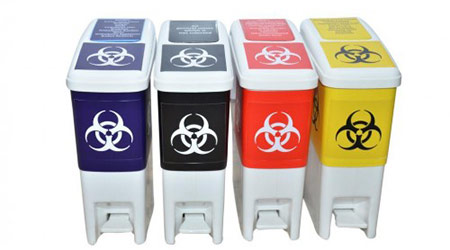Due to the wide variety of hazardous chemicals and materials stored and handled at healthcare facilities, hazardous waste accumulation has grown year to year. Regulating agencies, such as California EPA’s Certified Unified Program Agencies (CUPA), have recently shifted focus towards hazardous waste management during their annual inspection.
As a result, there has been an increase in violations given to healthcare facilities for unknowingly being out of compliance. Therefore, it is important for all healthcare personnel who handle hazardous chemicals or materials to be made aware of these improper practices and be trained accordingly. A few common examples are provided below:
Point of generation
With multiple departments on-site, a facility may elect to have all hazardous waste transported to a central area for inventory control and disposal. However, this results in a violation as hazardous waste must be segregated, containerized, and labeled at the point of generation. Hazardous waste should not be transported around the facility unless the abovementioned measures are taken.
Incorrect generator status
For facilities with no central handling, each department may manage their own hazardous waste separately and may consider themselves as a Small Quantity Generator (SQG) when reporting to the EPA. However, the accumulation of hazardous waste from every department on-site may result in the entire facility being categorized as a Large Quantity Generator (LQG). A violation can be assessed for incorrect generator status. EPA ID numbers are site specific and can encompass the entire facility.
Illegal disposal
Employees may incorrectly dispose hazardous chemicals into the medical waste container or down the sanitary sewer. Inspectors may review the labels of the empty containers in the medical waste container to ensure there are no hazardous chemicals listed. For these instances, it is important for healthcare personnel to be able to identify the differences between hazardous and medical wastes.
Unauthorized/illegal treatment
Some chemicals may require authorization by a supervisor in order to be treated for disposal. Furthermore, chemicals must be properly neutralized and/or correctly disposed of as hazardous waste. Authorization records should be kept and made available during an inspection, if requested.
Improper manifesting
Because of unauthorized/illegal treatment, a hazardous waste manifest may have the incorrect waste description or list the incorrect waste code. This also includes any additional descriptions or hazardous waste codes missing from the manifest. Please note that hazardous waste manifest should always be signed by a responsible official to ensure it is completed accurately.
Improper hazardous waste identification
Without proper labeling on-site, some hazardous waste may be commingled with other hazardous waste streams. This also results in incorrect manifest descriptions and codes. All applicable descriptions and hazardous waste codes must be correctly identified prior to disposal.
It may seem that once the generated hazardous waste leaves the facility, the process is complete. However, when the waste reaches the Treatment, Storage, and Disposal Facility (TSDF), the hazardous waste manifest and hazardous waste identification are verified for accuracy. Improper practices can be traced back to the generator and the facility may be flagged by the regulating agency for an inspection.
Hazardous waste management is just one of many components during a regulating agency’s annual inspection, yet, healthcare facilities should account for all aspects during their facility audit in order to avoid a Notice of Violation.
Karl Jerome Bacho is an Associate Consultant for EHS and Air for ALTA Environmental, a California-based consulting firm providing strategic advice and services throughout the Western United States.

 UF Health Hospitals Rely on Green Globes to Realize Their Full Potential
UF Health Hospitals Rely on Green Globes to Realize Their Full Potential How Healthcare Facilities Can Be Truly Disaster-Resilient
How Healthcare Facilities Can Be Truly Disaster-Resilient TriasMD Breaks Ground on DISC Surgery Center for San Fernando Valley
TriasMD Breaks Ground on DISC Surgery Center for San Fernando Valley Bigfork Valley Hospital Falls Victim to Data Breach
Bigfork Valley Hospital Falls Victim to Data Breach AI-Driven Facilities: Strategic Planning and Cost Management
AI-Driven Facilities: Strategic Planning and Cost Management